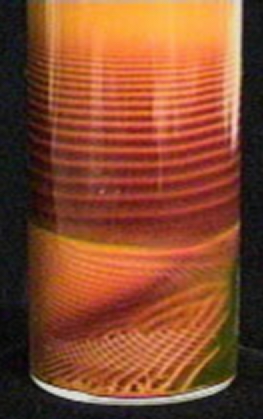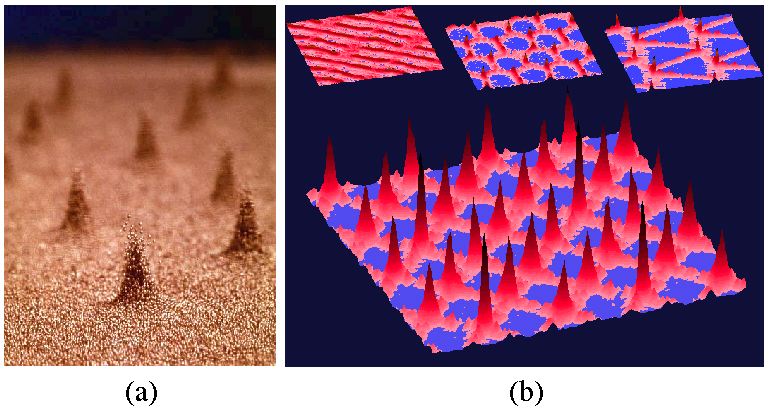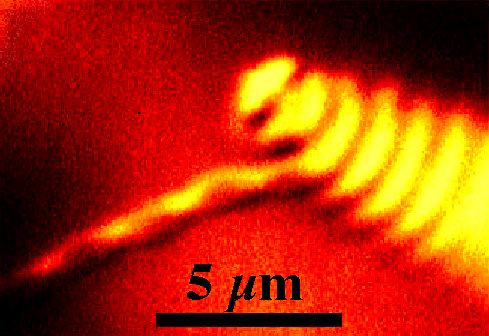Patterns From Noise
[Shinbrot,
Nature 410 (2001), 251 - 8]
- Presto,
Innate Forms: Background
Patterns in natural systems abound, from the stripes on a zebra
to ripples in a riverbed. In many of these systems, the appearance
of an ordered state is not unexpected as the outcome of an underlying ordered
process. Thus crystal growth, honeycomb manufacture and floret evolution
generate regular and predictable patterns. Surprisingly similar patterns
are generated by intrinsically noisy and disordered processes such as thermal
fluctuations or mechanically randomized scattering. In this work,
we examine some of the underlying mechanisms believed to be at the heart
of these similarities.
- Note firm operants:
The Second Law of Thermodynamics:
Maxwell's Demon is the paradigmatic thought experiment used
to challenge the Second Law , and consists of the hypothetical process
of extracting heat from a gas by opening an imaginary door separating two
chambers only when high speed (i.e. hot) molecules approach the door from,
say, the right. A meticulous analysis of the actual energy
required to implement such a machine reveals that the Second Law is sound
because the minimum expenditure of energy needed to detect and respond
to fast particles is nonzero and in fact exactly equals that predicted
by quantitative forms of the Law [Caves et al., Phys. Rev. Lett 65
(1990) 1387].
In the case of granular physics, where much recent research
on noise and pattern formation has focused, a surprising result is obtained
however. This result, first discussed in 1996 [Schlichting
et al., Math. Naturwiss. Unterr. 49 (1996), 323-332] and since
analyzed in detail [Eggers, Phys. Rev. Lett. 83 (1999) 5322-5]
, is epitomized in the figure below, where we display the results of an
experiment in which a number of steel beads were initially uniformly distributed
across a vibrated acrylic container. The container is separated
into two identical chambers by a foamboard barrier containing an open window
near its bottom.
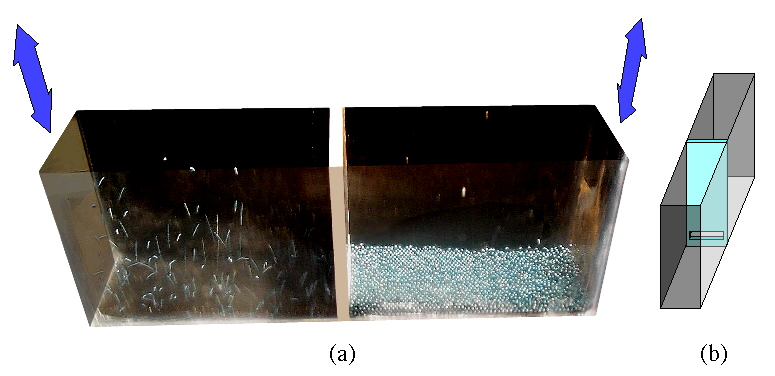
|
Granular
Maxwell' s Demon
(a) Snapshot of spontaneous separation between gas-like and solid-like
2 mm diameter steel balls from experiment in which a acrylic container
is vibrated sinusoidally at 10 Hz and a maximum acceleration of 1.3 times
gravity. The beads are initially distributed uniformly across the
container, and due to collisional inelasticity migrate to whichever side
randomly acquires a slight excess of balls. (b) Schematic of container
which is divided into two chambers by a barrier containing a window 6 mm
high beginning 6 mm from the bottom of the container.
|
- On a persistent form:
Patterns from first order processes
Evidently and against expectation, ordering of large-scale
particles into gas-like and frozen states can arise spontaneously.
The ingredients required to produce this outcome are a source of noisy
energy (here the shaking of the container) and a source of dissipation
(here the inelasticity of the particles). The same ingredients on
the micro-scale produce regular ordering in a variety of natural situations
as well [Ball, The self-made tapestry, pattern formation in nature
(Oxford U. Press, Oxford UK 1999)]. Historically, one of the earliest
mentions of this kind of ordering -- and one of the most elegant systems
in which it can be produced -- is the production of layered geological
specimens, where 'Leisegang bands' of precipitating reactants can spontaneously
form stripes and other patterns in otherwise static gels.
- Or tramp fine stones:
Patterns from macroscale noise
Patterns are seen on all scales; from the microscopic to the
astrophysical. On laboratory scales, a variety of striking patterns
have been reported, among the most intriguing of which are 'oscillons',
consisting of a state of peaks and dips that alternate on successive vibration
cycles . An experimental example of an array of oscillons from Paul
Umbanhowar and Harry Swinney is shown below, alongside a model that produces
several other patterns, some of which are seen experimentally and one that
has not been seen to date.
- Assent
from protein: Liquid crystal patterns
Colloidal ordering has been known for many year to be governed
by entropy . This is important in a number of technological problems,
including the generation of liquid crystal displays and the fabrication
of polymer composites. Intriguing examples in biological systems
have also been found. As an example, the figure below displays an
intermediate stage in the kinetics of the isotropicsmectic transition
of a polymer/virus mixture, from Zvonimir Dogic and Seth Fraden.
- A form is not present:
When do disordered states occur?
Spontaneously organized patterns can be formed by combining
little more than noise (or diffusion) with dissipation (or complex reactions)
in a symmetric system. Why is it, then, that in some problems a disordered,
homogeneous state results, while in seemingly similar circumstances ordered,
heterogeneous patterns appear? On probabilistic grounds,
one can conclude that the physically realized states that Nature chooses
will correspond to the ones that maximize the number of possible particle
rearrangements. By counting all possible states, one finds that so-called
'entropic ordering' can favor either macroscopically heterogeneous or homogeneous
states with a transition at calculable values of order parameters such
as constituent concentrations. Remarkably, states in which like particles
separate can be strongly favored in randomized systems, and separated states
can be enormously more probable than any mixed state.
This has long been known in colloidal and polymeric systems.
In granular physics, there are indications that entropic ordering may also
govern segregation of dissimilar particles. In the figure,
below, we have vibrated a 5 mm deep blend of large (gold) and small (maroon)
glass beads under identical conditions, but at three different sets of
concentrations. At high concentration of small beads (a), the small
and large beads separate cleanly, each species favoring positions near
walls. As the relative concentration of small beads is reduced, the
entropic advantage of mixing grows with respect to that of separation,
and only a small region (bottom right of (b) of segregated small beads
is seen. Finally the entropy of the mixed state exceeds that of the
homogeneous state, which finally prevails when the weight fraction of small
beads in the bed drops below about 11% (c).
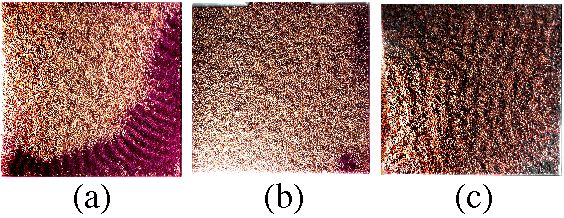
|
|
Possible granular transition between mixing and segregation of
1.8 mm (gold) and 0.8 mm (maroon) glass beads. Vibration is approximately
sinusoidal with peak acceleration 3.9 times gravity and frequency of 20
Hz. Under fixed conditions, the concentrations (as a weight fraction of
the total granular bed) of small beads in the three snapshots are (a) 30%;
(b) 12%; (c) 11%. Striped patterns, characteristic of vibrated
grains, are evident in the figure but play no known role in the entropic
segregation mechanism..
|
- Frontier Map Notes:
Outlook
It has been said that any sufficiently advanced technology
is indistinguishable from magic. The inseparable facts that continue
to attract researchers to the study of patterns generated from noise are
that the mechanism for their formation is extremely basic, yet even once
the mechanism has been thoroughly dissected and understood, its outcome
still seems like magic. The paradox that the spontaneous formation
of these patterns seems to be simultaneously completely implausible and
hugely probable is difficult to reconcile with a rational and systematic
analysis of the natural world. This situation has given rise to several
unresolved, and possibly unresolvable, questions that are topics of ongoing research.

